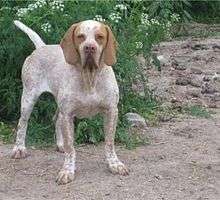Pachón navarro
The pachón navarro (plural pachones navarros) is a type of Spanish hunting dog which often has the unusual feature of a bifid nose (a split nose that even look like a double nose). It was formerly believed that this unusual trait gaves it extra sensitivity to smells, a primary reason it was chosen as a hunting dog. Today, it is known that this feature is only a cosmetic difference.[1] The variety is also known by other names: Navarra pointer, Spanish: pachón de Victoria and perdiguero navarro; Basque: nafarroako eper txakur.
| Pachón navarro | |
|---|---|
 | |
| Other names | Navarra pointer, perdiguero navarro, pachón de Victoria, nafarroako eper txakur |
| Origin | Navarre (Spain) |
| Breed status | Not recognized by any major kennel club. |
| Dog (domestic dog) | |
Description
The modern pachón navarro is a braque-type hunting dog which points to game. It has short hair that may be brown and white, or orange and white, commonly ticked like the coat of most German Shorthaired Pointers. The head and large patches on the coat are generally solid-colored.
With a broad head, the dog is a substantially large animal, weighing between 27 and 33 kg (60 and 73 lb) and having a height between 48 and 57 cm (19 and 22 in). Its ears are long.
History

The Fédération Cynologique Internationale and other major international kennel clubs do not recognize the pachón navarro as a standardized breed. The Spanish Kennel Club has accepted the pachón navarro as a breed.
The variety is thought to have descended from the Talbot hound and other hounds, originating in the 12th century. It is likely related to the Old Spanish Pointer, which it resembles in appearance.
The pachón navarro is believed to have reached its apex of popularity among Spanish nobility of the 18th and 19th centuries, becoming nearly extinct after the Spanish Civil War. A few enthusiasts scoured the country and have re-established breeding stock.
Double-nosed Andean tiger hound
A population which has been referred to as “double-nosed Andean tiger hounds” is believed to be a type of hound born with a bifid (split and possibly double-looking) nose, and presumed to be descended from the pachón navarro hunting dogs brought to South America by the Spanish Conquistadors in the 16th century. There is mention of a bifid-nosed hound in the Amazon Basin, at the village of Santa Ana in Mato Grosso, Brazil, in a 1913 report by explorer Percy Fawcett.[2][3][4] A dog fitting this description was more recently reported in Bolivia by explorer John Blashford-Snell. His first encounter with a bifid-nosed dog was in 2005 in an area near the village of Ojaki outside La Paz. On a return trip a short time later, he encountered a litter of puppies sired by such a dog crossed with a bitch that had a normal nose. Two of the four puppies had bifid noses but only lived three days.[5]
Conservation
This old, regional variety of dog is in danger of extinction; in March 2007, there were counted between 70 and 80 pure-bred exemplars. Today, its growth is promoted through an association created to preserve it and establish it as a standardized breed, without altering its defining features.[6]
References
- "Rarest Video Games Ever and more". YouTube. 30 August 2013. Retrieved 11 December 2017.
- Terry Breverton (2013). Breverton's Phantasmagoria. New York: Quercus. p. 433. ISBN 978-1-62365-235-7. Retrieved 15 November 2018.
- Fawcett, Percy H. (2016). Lost Trails, Lost Cities. San Francisco: Hauraki Publishing. ISBN 978-1-78720-078-4. Retrieved 15 November 2018. This posthumous collection of writings was also published as Exploration Fawcett.
- Lawlor, Eric (1989) [1953]. In Bolivia. Vintage Books. p. 220. ISBN 978-0-39475-836-7. Retrieved 15 November 2018.
- "Double-nosed dog not to be sniffed at". BBC News. 10 August 2007. Retrieved 12 September 2019.
- "Cronología: Resumen verdadero de acontecimientos". Pachonnavarro.com. Retrieved 11 December 2017.